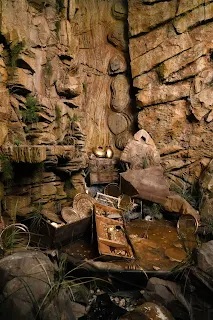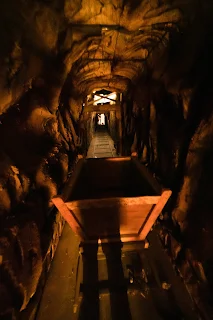Also in this issue
- More Banding Examples
- The Youtube Video I'm Sorry I Made
- In the Pipeline
- Interesting Things I Discovered about the Sony RX100 VII
BTS on a Hollywood Movie Set
Recently I did some Behind The Scenes stills for a Hollywood movie called "The Treasure of Pirate's Cove". It's a kid's film that borrows heavily from every action film genre in the last 50 years including Indiana Jones, National Treasure, and [generic pirate time travel movie plot here]. Actor Malcolm McDowell played the ship's captain, and I have to tell you it's a joy to watch competent people in their element.
Thinking "This is a Hollywood Movie, so they'll be using lots of light" I left my f/2.8 and faster lenses at home. Turns out that was a mistake - even the daylight scenes were lit with no more than 3 diffused lights. And they were old LED light banks, which provided its own set of problems when you're shooting silently (as one must do for this kind of assignment).
The filming took place in a non-descript building in downtown Los Angeles, where the most basic details of a ship were constructed. (As always, click on any picture to view them larger and sharper.)
 |
| Two pirates standing outside a non-descript building in downtown Los Angeles. |
 |
| The basics of a ship. It's amazing how lighting can distract from the skeletal set. This was the work of the art director, Steve Luchsinger. |
And there was the usual Indiana Jones-style treasure and mining carts as well.
 |
| Here are the primary actors. The Treasure of Pirate Cove is a Hip Films production. |
Here's a quick video with some highlights of the filming:
I brought both an A7R II and A7R III (thinking it would be faster than changing lenses); 70-200 f/4 G, 24-105 f/4 G, 12-24 f/4 G, and an RX-100 V. All cameras were on manual exposure mode because none of these scenes or lighting were average and any other exposure mode (P, A, S) would have resulted in images looking about 2 stops overexposed. Both A7 cameras were set to Silent Shooting mode, whose quietness is required in an environment like this. About an hour into the day I put the A7R II away because of banding issues (which I talk about below).
 |
| And the crew. |
 |
| The Happy Sound Guy |
 |
| The Happy Director of Photography (Justin McAleece) |
 |
| Nighttime lighting wasn't much different - the bright light in back simulated the moon, and the orange lights were... oil lanterns? Don't know, but the lighting was minimal and effective! |
 |
| Focus mode was either set to Center or Manual since there was usually too much stuff in the way and it just would have confused the camera if I had kept it on "Wide". |
 |
| Michael Jackson Eyes |
 |
| You can't really see it, but this guy's using a Canon DSLR in a soundproof "blimp" so the shutter sound won't be picked up by the microphones. He was amazed at my A7 cameras but kept lamenting that he couldn't justify the expense of switching systems. (He's not alone. That's why even in this day and age every press conference continues to have a cacophony of shutter sounds from press photographers. But I digress...) |
 |
| Craig Albrecht, Producer (left) and Rick Spalla, Director (right). |
If you think making Hollywood movies is a glamorous business, think again. It can be hard work (even for the actors) with long hours for weeks on end. You're either working 24/7 or your not working at all (with no idea where your next project is coming from.) Glad I'm not in this business; but I always marvel at how the lighting guys do their thing.
In the Pipeline
The French version of the A7 III ebook is out! (This compliments the Spanish version released a month ago.)
I'm also working on the RX-100 VII ebook (more on that below) and will start on the one for the A7R IV just as soon as mine arrives. Email me if you'd like to be put on the waiting list.
Next Time in Cameracraft
Imagine being paid to fly around the world to hunt down
the best certified organic coffee and the farmers who grow them, develop
sustainability programs for those farmer communities, and take marketing photos
for a coffee company to tell their stories one environmental portrait at a
time. Now imagine you’re a Jewish kid
and discovered you’re a descendant from Ethiopian nobility dating back 1,000
years. And to top it off you then get to
reconnect with your newfound relatives while on a business trip.
For the next issue I profile Jeff Chean, Chief Coffee Guy at Groundwork Coffee. Read all about his family reunion and the time some folks in Ethiopia sacrificed a goat in his honor.
For the next issue I profile Jeff Chean, Chief Coffee Guy at Groundwork Coffee. Read all about his family reunion and the time some folks in Ethiopia sacrificed a goat in his honor.
Yup, stories and technical insights you just won't find anywhere else. Subscribe today and support the last of the old-style photography magazine!
Upcoming Seminars
Copenhagen September 14-15, 2019 (not too late to sign up!) Learn More and Sign Up
Indio, California January 11-12, 2020 Learn More and Sign Up
South Carolina - April 2020 (email me to be added to the waiting list)
St. Louis, Missouri - May 30-31, 2020 (email me to be added to the waiting list)
Also hoping to nail down an event in Oregon next year. Stay tuned.
Not familiar with the seminars? Can't attend these events? Then check this out.
The Youtube Video I'm Sorry I Made
I never know which of my youtube videos will be popular. So far the top 2 are the one I made about the 10 Best and Worst Minoltas ever made back in 2012, and the one explaining the nuances between the varied LA-EAx A-mount to E-mount adapters offered by Sony.
I'm sorry I made that last one. And it's not just because I forgot to use foundation makeup to make my skin look palatable to the camera:
 |
| Youtube video (no makeup) Youtube video (with makeup) |
[Scholarly note: Because the camera and the eye see things differently, makeup is actually needed for everyone who wants to look good. That's why all film and television actors use it. That's one reason why all fashion models use it. And it's certainly beneficial when it comes to my face. :-) ]
I originally made this video because I grew tired of answering the endless "I have XXX lens and YYY camera - which adapter should I get?", and once published I was hoping that those kinds of questions would go away. Instead it had the opposite effect. Despite trying to explain things in a clear and intuitive way, and despite providing a written summary of the take-aways in the video's description, more people (including people who never bought my books) saw me as an expert and the incidence of email queries increased. The road to hell is paved with good intentions.
I'm so sorry I made that first one that I've made a 2nd video - a sequel - which I'm sure will garner nowhere near the same level of questions :-). Enjoy.
Interesting Things I Discovered about the Sony RX100 VII
I've had my RX100 VII for less than a week now. Yes, it's as good as you've read, mostly because it seamlessly identifies the subject (faces, eyes) and then tracks that subject as it moves across the frame as fast as an A9. You don't have to press a button to get eye AF. It can focus on your pet's eyes instead of its nose (usually cameras focus on a pet's nose, because the heuristic is "focus on the closest thing if you don't see a face"). Once properly configured, all you really have to do with this camera is point and shoot.
In my work on the ebook, I've discovered a couple of interesting things so far.
First, I am THRILLED that Sony added the ability to bring up the "My Menu" screen at the press of a pre-assigned button! I called them out on that in previous books.
Second, one of my favorite obscure features is the Auto Monitor Off function (present in the RX100 VI as well). Here's why it's useful: This camera has a small battery, and the display (along with Live View) eats up a lot of power even if you're just waiting for something important to happen, like someone blowing out birthday candles. In the past I'd turn the camera off until just before the event to save the battery, but then it can take as long as 3 seconds to turn the camera back on and have it ready to shoot.
So this feature just puts the camera into a power-saving mode, without retracting the lens. In essence, the camera is still on; but the display is disabled, eliminating the the power associated for the camera to shovel data from the sensor to the display 60 times a second. The camera is still awake and ready – just touch the shutter release button and the camera is instantly ready to shoot. More than anything, for me this feature represents a major stress reliever.
Third, I discovered that you can't select an ISO above 6400 if you're in Continuous Shooting drive mode. Now why would that be? Usually when features are disabled in fast-shooting modes it's because the post-processing needed to implement them takes too long and slows down the shot-to-shot time. But previous cameras never had this limitation. Could it be that there's a new Über-awesome high-ISO noise reduction algorithm at work here, necessitating the restriction?
I took a couple of test shots to find out. On a tripod, extremely low light, ISO 12,800. As with everything else in this blog, click on an image to view larger and sharper.
 |
| Contents of the two yellow rectangles are compared below. |
 |
| RX100 V RX100 VII |
 |
| RX100 V RX100 VII |
They are definitely different, but I can't say one is actually meaningfully better than the other.
Send me an email (Gary at Friedman Archives dot com) if you'd like to be notified when the e-book is ready.
Until next time,
Yours Truly, Gary Friedman
 |
| A three hour tour. |













Hi Gary,
ReplyDeleteIMHO the RX100V shot above looks smoother, which I prefer, than the RX100VII.
Low noise and high detail are tradeoffs...
DeleteThis is your best blog post ever! I love behind the scenes footage of... anything!
ReplyDeleteGary
ReplyDeleteJust purchase a RX100 VII and will want to purchase your book asap. Please email me at drd@kos.net when the book is available.
Ross Drummond
Thank you for the monitor off mention as I don't like the "on to shoot time" on my rx100VI.
ReplyDelete